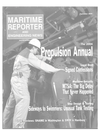
"Ship Design and Construction"
SNAME publishes many good textbooks on naval architecture. All the more we can welcome the completely revised new edition of "Ship Design and Construction" published by the Society of Naval Architects and Marine Engineers.
In 1980, the "Taggart" (editor) third edition became quickly a standard reference for naval architects. Now, with three years delay, a new edition is available, compiled and edited by Professor Thomas Lamb of the University of Michigan. The purpose of the book, as summed up by Lamb in his introduction chapter, is to assist ship designers and ship- builders make better design decisions by providing the required knowledge in one relatively easily accessible source, provide a book that can be used by naval architecture students to learn about ship design and construction, and serve as a reference when they enter the marine industry.
Lamb succeeded marvelously in this endeavor. Differing from the earlier editions, this time a pool of international experts was compiled to write the book.
Although naturally the majority of authors are from the U.S., contributions by internationally renowned authors from Australia, Belgium, Canada, Denmark, Finland, France, Germany, Great Britain, Italy, Japan, Korea, and Norway add competence and experience in a wide range of aspects.
The first 16 chapters give an overview of the industry (its interaction between customers and suppliers), design methodology and relevant elements and tools. Ship hydrodynamics are virtually excluded which can be accepted in view of existing textbooks dedicated to ship hydrodynamics and its interaction with design. Chapter 14 covers the integration of design and production, preparing the ground for the subsequent chapters 17 to 26, which cover various aspects of ship structural design and construction.
Chapters 27 to 55, i.e. half of the book, are dedicated to the design of individual ship types, from tankers and bulk carriers to fishing vessels and dredgers. The descriptions gives historical development and typical general arrangement plans, sometimes even lines, of the various ship types, but falls short of supplying individual design estimation formula, perhaps in view of the increasingly advocated and described first-principle design. Also Chapter 10, Parametric Ship Design provides such formulae, which can be adapted to the different ship types.
In sum, we have here a compact textbook closing internationally a gap for modern ship design and construction of commercial and naval ships. Literature references (again usually reflecting modern state of the art) in the individual chapters allow dedicated further studies of the individual aspects covered.
Thomas Lamb and the chapter authors, are to be congratulated for a job well done. The book should be on every naval architect's and shipbuilder's bookshelf.
"Ship Design and Construction " (4th Edition, Ed. Thomas iMtnb) Volker Bertram The list price for the two-volume set is $260, and the members' price $200, plus shipping. The student price is $150, plus shipping.
Order on-line at http://www.sname.org/publications_ sale.htm or contact Rich Mouk at [email protected].
Other stories from September 2004 issue
Content
- SSI Concerns Continue page: 5
- Signed Confessions page: 9
- OMI to Pay $4.2M for Waste Oil Dumping page: 14
- NASSCO Delivers Alaskan Frontier page: 17
- Alabama Shipyard to Build Hopper Dredge page: 17
- Merwede Tapped for Navy, Commercial Contracts page: 18
- FBM Babcock Wins U.S. Contract page: 19
- New Vessels from VT Halmatic page: 19
- ABCO Launches Three New Boats page: 20
- IR Generates $64M in Orders page: 24
- Sideways to Swimmers: Unusual Tank Testing page: 26
- Current Uses of FEA in Shipbuilding page: 30
- BMT Aims to Improve Vessel Evac page: 32
- Flensburg Makes its Mark Again page: 36
- SMM 2004: Ready for the World page: 36
- German Shipyards Propose Merger page: 37
- Voith to Exhibit VWT Baut at SIMM page: 37
- Blohm + Voss Repair Wins Business page: 38
- Methane Arctic Benefits from German Technology page: 39
- Becker Kort Rudder Nozzles for Improved Maneuverability page: 40
- Payer Presented Cross of the Order of Merit page: 42
- Xantic: Focus on Integrated Solutions page: 44
- A Benchmark in Electronic Fuel Injection page: 45
- Q&A with Wartsila CTO Matti Kleimola page: 46
- Seacor Crewboats "Eliminators" Some Maintenance Costs page: 49
- (Fuel) Cells of Endeavor page: 50
- Containerships: When Will One Engine Not Be Enough? page: 52
- Most Powerful Common- Rail Engine Passes Test page: 54
- Clean Concept for Brostrom Tankers page: 54
- Canadian Towing Firm Refits for the Future page: 56
- TOR: The Next-Generation Turbocharger page: 57
- Duramax Marine Creates Largest Ever DuraCooler page: 58
- ABS: Large Ship Hull Deflections Impact the Shaft Alignment page: 60
- The Great Maritime Disruption... that Never Happened page: 66
- New Positioning Technique Helps Cut Costs in Deepwater GOM page: 76
- U.S. Ferry Market Prospects Looking Up page: 77
- "Ship Design and Construction" page: 81

